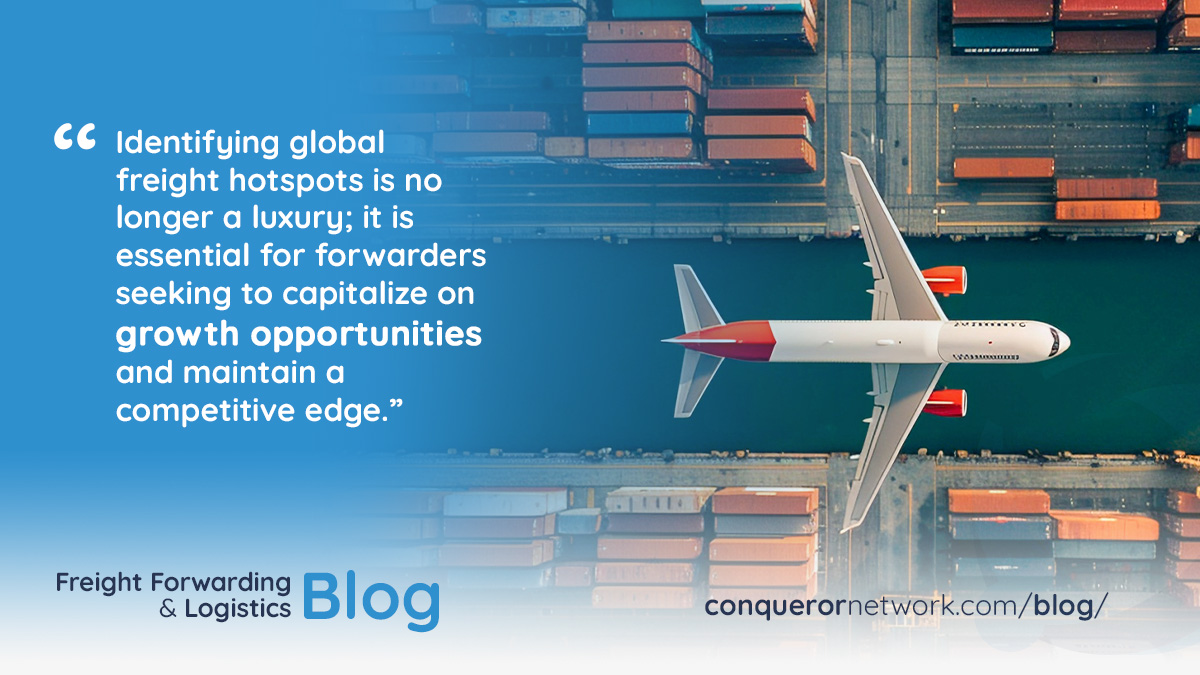The logistics world is constantly evolving, and staying ahead requires more than just operational efficiency. Forwarders who want to succeed in the coming year need to know where the demand will spike, which trade routes are expanding, and how international logistics trends are shaping the global market. As 2026 approaches, identifying global freight hotspots is no longer a luxury; it is essential for forwarders seeking to capitalize on growth opportunities and maintain a competitive edge. In this article, we explore the regions and trade lanes that will define global freight in 2026, offering insights that can help freight forwarding companies plan, strategize, and expand their reach.
Rising Demand in Asia-Pacific Freight Corridors
Asia-Pacific has long been a powerhouse in global trade, but in 2026 certain freight corridors are expected to experience unprecedented growth. China remains central to international logistics, with ports like Shanghai, Shenzhen, and Qingdao continuing to handle massive volumes of ocean freight. These hubs are critical not just for domestic supply chains but for connecting Asia to Europe and North America. Forwarders need to pay close attention to shipping schedules, capacity constraints, and port regulations in these regions.
Meanwhile, Southeast Asia is emerging as a significant player. Countries such as Vietnam, Thailand, and Indonesia are expanding manufacturing capacities and investing in port infrastructure. This growth translates to new opportunities for freight forwarders, particularly those handling project cargo and high-value goods. Air freight companies will find increased demand on routes connecting major Southeast Asian cities to North America and Europe. Freight forwarding trends 2026 suggest that businesses prioritizing these routes can position themselves as reliable partners in high-demand markets.

The Resurgence of Transatlantic Routes
While Asia-Pacific dominates headlines, transatlantic routes are experiencing a renaissance of their own. The United States and Europe remain central to international trade, and in 2026, freight forwarders should anticipate growing volumes in both directions. Air freight trends indicate that technology and e-commerce-driven demand are driving rapid shipments from European hubs to American markets. Cities like Frankfurt, Paris, and Amsterdam are expected to see heightened activity in air and ocean freight.
Ocean freight remains vital along these corridors. Forwarders who understand the nuances of shipping schedules, customs procedures, and container allocation can gain a decisive advantage. Emerging trade routes between smaller European ports and the East Coast of the United States are also gaining traction. These corridors, often overlooked in traditional freight planning, are becoming lucrative spots for agile freight forwarding companies.
Opportunities in Africa and Latin America
Africa and Latin America are no longer peripheral players in international logistics. By 2026, these regions are expected to emerge as essential global freight hotspots. Africa, in particular, is benefiting from infrastructure investments and trade agreements that facilitate smoother cross-border operations. Ports in Morocco, Nigeria, and Kenya are attracting larger shipments, and air freight companies are increasingly active in connecting these hubs to Europe, Asia, and the Middle East. Forwarders who establish early partnerships in these regions can position themselves as leaders in markets that are set to expand rapidly.
Similarly, Latin America presents a mixture of opportunities and challenges. Countries such as Brazil, Chile, and Mexico are experiencing growing demand for both inbound and outbound freight. Forwarders must navigate local regulations, customs complexities, and evolving infrastructure to succeed. However, the potential rewards are significant. Project cargo shipments, in particular, are increasing due to mining, energy, and manufacturing projects. Keeping an eye on emerging trade routes and integrating them into logistics strategies will be critical for companies looking to grow in 2026.
The Role of Technology in Freight Forwarding Opportunities
Technology is not just changing the way goods move; it is redefining the global logistics landscape. Digital platforms that offer real-time tracking, predictive analytics, and optimized routing are becoming standard tools for freight forwarders. In 2026, forwarders who leverage these technologies will have a distinct advantage in navigating global freight hotspots.
Data-driven insights allow companies to anticipate congestion, identify the most efficient shipping lanes, and manage risks associated with customs delays or port disruptions. Air freight trends 2026 suggest that customers increasingly expect transparency and speed, and forwarders who can deliver both will capture the most valuable contracts. International logistics is no longer about moving goods from point A to point B; it is about offering solutions that optimize cost, time, and reliability simultaneously.
Strategic Focus on Niche Markets
Identifying global freight hotspots is not only about following high-volume corridors; it is also about spotting niche markets that promise high margins. Project cargo, perishable goods, and high-value shipments are seeing growing demand in multiple regions. Freight forwarding trends 2026 indicate that companies specializing in these sectors can differentiate themselves by providing tailored solutions.
For example, heavy machinery shipments in Africa or Latin America often require specialized handling, permits, and transport modes. Forwarders who invest in expertise and equipment for these types of cargo can secure contracts that less-prepared competitors might miss. Similarly, high-value electronics and medical supplies demand precision and speed, offering forwarders an opportunity to leverage technology and knowledge for a competitive edge.
Preparing for Regulatory Changes and Sustainability Demands
Another factor shaping global freight hotspots in 2026 is regulatory and sustainability requirements. Countries are increasingly implementing policies that affect freight movement, such as stricter emissions rules, carbon reporting, and customs compliance standards. Forwarders who anticipate these changes can integrate solutions into their services, enhancing value for clients while remaining compliant.
Sustainable logistics is no longer optional. Companies investing in eco-friendly shipping options, fuel-efficient routing, and carbon offset programs are positioning themselves favorably in competitive markets. As international logistics evolves, clients will prioritize partners who can offer sustainable solutions without compromising efficiency. Forwarders that align their operations with these trends are likely to see growth in multiple global freight hotspots.
Conclusion: Seizing Opportunities in 2026
Global freight hotspots 2026 are spread across continents and sectors, from established transatlantic lanes to emerging African and Latin American markets. Forwarders who stay ahead of freight forwarding trends 2026, understand international logistics, and leverage technology will be the ones to capitalize on these opportunities. By focusing on high-demand corridors, niche markets, and sustainable solutions, companies can not only grow but also build resilience against disruptions and shifting market dynamics.
For freight forwarders, the year ahead is full of potential. Those who identify the right hotspots, anticipate regulatory changes, and align their services with client expectations will be best positioned to thrive. Understanding where to focus next is not just a strategic choice; it is a necessity for anyone aiming to lead in the increasingly complex world of international logistics in 2026.


